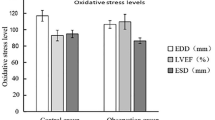Summary
Background
Cardiac surgery is associated with inflammation and oxidative stress; malondialdehyde (MDA) is a marker of oxidative stress and osteopontin (OPN) is a proinflammatory cytokine. We studied MDA kinetics following coronary artery bypass grafting (CABG) and its relation to OPN.
Methods
We evaluated 50 consecutive patients (60 ± 10 year-old, 44 men and 6 women) with stable coronary artery disease and left ventricular ejection fraction of 50 ± 8 % undergoing elective CABG on pump. Peripheral plasma samples were drawn at baseline, 24 and 72 h postoperatively. OPN was evaluated at baseline and MDA and cardiac enzymes at all time points.
Results
MDA levels increased significantly at 72 h postoperative compared with preoperative and 24 h postoperative levels whereas there was no difference between the pre and first postoperative values (p = 0.67). MDA change was positively correlated with the change in troponin at baseline and at 72 h (r = 0.6, p = 0.022) as well as with preoperative OPN levels (r = 0.28, p = 0.047). There was a significant positive correlation between MDA at 72 h and age (r = 0.27, p = 0.039). In addition, MDA change differed significantly in relation to diabetes at baseline and at 72 h—2.99 (4.77) in diabetics versus 0.69 (3.82) in non-diabetics (p = 0.05).
Conclusions
MDA increases post on-pump CABG but only at 72 h and this increase correlates with preoperative OPN levels. In addition, MDA increase is related to age and diabetes as well as troponin increase following surgery.


Similar content being viewed by others
References
Gerritsen WB, van Boven WJ, Driessen AH, Haas FJ, Aarts LP. Off-pump vs.on-pump coronary artery bypass grafting: oxidative stress and renal function. Eur J Cardiothorac Surg. 2001;20:923–39.
Luyten CR, van Overveld FJ, De Backer LA, et al. Antioxidant defence during cardiopulmonary bypass surgery. Eur J Cardiothoracic Surg. 2005;27:611–6.
Biglioli P, Cannata A, Alamanni F, et al. Biological effects of off-pump vs on-pump coronary artery surgery: focus on inflammation, hemostasis and oxidative stress. Eur J Cardiothoracic Surg. 2003;24:260–9.
Ashizawa N, Graf K, Do YS, et al. Osteopontin is produced by rat cardiac fibroblasts and mediates A(II)-induced DNA synthesis and collagen gel contraction. Clin Invest. 1996;98:2218–27.
Xie Z, Singh M, Singh K. ERK1/2 and JNK’s, but not p38kinase, are involved in reactive oxygen species-mediated induction of osteopontin gene expression by angiotensin II and interleukin-1 beta in adult rat cardiac fibroblasts. J Cell Physiol. 2004;198:399–407.
Georgiadou P, Iliodromitis EK, Varounis C, et al. Relationship between plasma osteopontin and oxidative stress in patients with coronary artery disease. Expert Opin Ther Targets. 2008;12:917–20.
Gerritsen WB, van Boven WJ, Boss DS, Haas FJ, van Dongen EP, Aarts LP. Malondialdehyde in plasma, a biomarker of global oxidative stress during mini- CABG compared to on- and off-pump CABG surgery: a pilot study. Interact Cardiovasc Thorac Surg. 2006;5:27–31.
Buckberg GD. Update on current techniques of myocardial protection. Ann Thorac Surg. 1995;60:805–14.
Davies SW, Underwood SM, Wickens DG, Feneck RO, Dormandy TL, Walesby RK. Systemic pattern of free radical generation during coronary bypass surgery. Br Heart J. 1990;64:236–40.
Cavalca V, Sisillo E, Veglia F, et al. Isoprostanes and oxidative stress in off-pump and on-pump coronary bypass surgery. Ann Thorac Surg. 2006;81:562–7.
De Vecchi E, Pala MG, Di Credico G, et al. Relation between left ventricular function and oxidative stress in patients undergoing bypass surgery. Heart. 1998;79:242–7.
Concoran TB, Engel A, Sakamoto H, O’Shea A, O’Callaghan-Enright S, Shorten GD. The effects of propofol on neutrophil function, lipid peroxidation and inflammatory response during elective coronary artery bypass grafting in patients with impaired ventricular function. Br J Anaesth. 2006;97:825–31.
Curello S, Ceconi C, de Giuli F, et al. Oxidative stress during reperfusion of human hearts: potential sources of oxygen free radicals. Cardiovasc Res. 1995;29:118–25.
Hamdy NM, Suwailem SM, El-Mesallamy HO. Influence of vitamin E supplementation on endothelial complications in type 2 diabetes mellitus patients who underwent coronary artery bypass graft. J Diabetes Complications. 2009;23:167–73.
el-Mesallamy H, Suwailem S, Hamdy N. Evaluation of C-reactive protein, endothelin-1, adhesion molecule(s), and lipids as inflammatory markers in type 2 diabetes mellitus patients. Mediators Inflamm. 2007;2007:73635.
Ergul A, Johansen JS, Strømhaug C, et al. Vascular dysfunction of venous bypass conduits is mediated by reactive oxygen species in diabetes: role of endothelin-1. J Pharmacol Exp Ther. 2005;313:70–7.
Ames BN, Shigenaga MK, Hagen TM. Oxidants, antioxidants, and the degenerative diseases of aging. Proc Natl Acad Sci U S A. 1993;90:7915–22.
Natarajan A, Samadian S, Clark S. Coronary artery bypass surgery in elderly people. Postgrad Med J. 2007;83:154–8.
Wang Y, Chen B, Shen D, Xue S. Osteopontin protects against cardiac ischemia reperfusion injury through late preconditioning. Heart Vessles. 2009;24:116–23.
Lee R, Margaritis M, Channon KM, Antoniades C. Evaluating oxidative stress in human cardiovascular disease: methodological aspects and considerations. Curr Med Chem. 2012;19:2504–20.
Conflict of interest
Eftihia Sbarouni, Panagiota Georgiadou, Constantinos Mihas, Antigoni Chaidaroglou, Demitris Degiannis, and Vassilis Voudris declare that they have no conflict of interest.
Author information
Authors and Affiliations
Corresponding author
Rights and permissions
About this article
Cite this article
Sbarouni, E., Georgiadou, P., Mihas, C. et al. Malondialdehyde kinetics following coronary artery bypass grafting and its relation to osteopontin. Eur Surg 46, 165–168 (2014). https://doi.org/10.1007/s10353-014-0280-x
Received:
Accepted:
Published:
Issue Date:
DOI: https://doi.org/10.1007/s10353-014-0280-x




